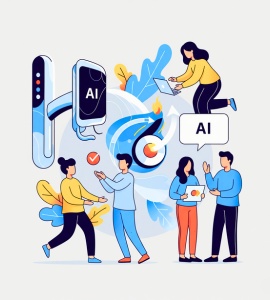We, at Experion, don’t just engineer products, we engineer purpose. In an era of intelligent machines and breakneck digital acceleration, we believe in pausing to ask: “What are we building, and why does it matter?” For us, technology is not an end, it’s a means to enrich lives, empower enterprises, and spark meaningful transformation.
The New Mandate: Intelligence That Serves, Not Surprises
AI has reached a turning point. What started as a powerful tool for optimization and prediction is now a decision-making layer across industries. With that comes the responsibility to shift from building smart systems to building responsible, intentional ones.
We don’t chase trends. We chase outcomes that move the needle.
Every product we co-create with our clients is rooted in a clear sense of purpose, whether it’s simplifying healthcare access for remote communities, enhancing transparency in insurance workflows, or crafting AI-powered tools that make classrooms more inclusive. Innovation, to us, must serve people first, not just platforms or pipelines.
We go beyond just ‘solutions.’ We build intentional breakthroughs, designed to deliver long-term impact and delight for the people who use them.
The best products don’t just scale, they uplift.
Connect with our AI experts today!
The Rise of Purpose in AI Innovation

In the early days of digital disruption, speed and scale were everything. Product teams were driven by the mantra of “move fast and break things,” with success measured in app downloads, user acquisition rates, and funding rounds. The emphasis was on getting to market first, often at the expense of depth, longevity, or even consequence.
But in the AI age, that mindset is evolving, dramatically.
We’re no longer just digitizing existing systems. We’re creating entirely new paradigms, tools that learn, reason, and make decisions autonomously. And with this power comes an unavoidable truth: we are building technology that can shape human behavior, influence critical decisions, and redefine fairness.
This shift demands a new kind of product thinking, one that places purpose, ethics, and empathy at the core.
Designing for Real-World Impact, Not Vanity Metrics
It’s easy to celebrate AI products that boost engagement by 30% or reduce bounce rates. But what does that really mean for the people using them?
Purpose-led teams are moving away from building for clicks, taps, and time-on-site. Instead, they’re asking deeper questions:
- Does this solution actually improve the quality of someone’s life?
- Is it making workflows more humane, not just more efficient?
- Are we measuring what truly matters, not just what’s easy to track?
Impact today is not a byproduct; it’s the brief. From early scoping to post-launch reviews, modern engineering leaders are prioritizing real-life outcomes over surface-level optics.
Prioritizing Human Outcomes Over User Activity
User behavior is a metric. Human well-being is a mandate.
In the age of AI, it’s not enough to simply track what users do, we need to understand why they do it and how the product affects their lived experience. That might mean designing for accessibility and inclusion, building interfaces that reduce cognitive overload, or training AI models to be culturally and contextually aware.
Every AI recommendation, prediction, or decision nudges the user. That’s a powerful position to hold. It requires not just technical excellence, but moral imagination, the ability to foresee unintended consequences and proactively design against them.
Engineering with Ethics, Empathy, and Equity
As AI becomes embedded in healthcare, finance, education, and public infrastructure, it starts to touch the most sensitive, high-stakes corners of human life. Which is why purpose-led innovation demands a foundation of ethical engineering.
This includes:
- Bias-aware model development: Ensuring training data reflects the diversity of real-world populations.
- Transparent decisioning: Making AI explainable and auditable, especially in regulated environments.
- User control: Designing systems that allow human override, consent, and understanding, so the AI empowers, not overpowers.
Empathy isn’t an abstract ideal, it’s a product requirement. Equity isn’t a social bonus, it’s a business imperative. Engineering with these values ensures that AI serves humanity, not just the bottom line.
Deepening Innovation, Not Slowing It Down
Some worry that all this talk of purpose, ethics, and impact might stifle innovation. In truth, it elevates it.
By asking harder questions, setting clearer intentions, and designing with greater care, we build products that are resilient, respectful, and relevant. We go beyond MVPs to build meaningful value propositions. We move from reactive delivery to proactive stewardship.
In short, we don’t slow down innovation, we deepen it.
The age of building “cool” AI is over. The age of building conscious AI has begun.
Purpose as a Product Strategy

In early digital transformation, product success was measured by speed to market, feature releases, and short-term metrics. But with AI-native products, the stakes are higher, and so are the expectations.
Today’s leading teams recognize that purpose is not a side note, it’s a strategy. It’s the filter through which every product decision is made, from roadmap to release.
Here’s how that plays out in practice:
- Problem First, Technology Later
The first question isn’t “Which model?” or “Which framework?” It’s “What human problem are we solving?”
Purpose-led teams spend disproportionate time understanding context, what’s broken, who’s underserved, and how success should feel, not just look.
- Engineering for Outcomes, Not Just Interfaces
It’s easy to ship features. It’s harder to ensure they produce tangible, sustained outcomes. That’s why engineering teams must work backwards from impact, designing for metrics that matter to people’s lives and livelihoods.
- Building Systems That Learn Responsibly
AI-native products are never “done.” They evolve. Which means ethical considerations, continuous monitoring, and explainability must be part of the product DNA, not a compliance checklist.
What “Delight” Looks Like in AI
In an era of intelligent automation, we often associate AI with logic, speed, and optimization. But here’s what’s missing from that picture: AI can also feel deeply personal. Done right, it doesn’t just operate efficiently, it connects intuitively.
When users engage with AI-powered experiences that feel tailored, empathetic, and invisible in all the right ways, they feel understood. They feel empowered. That subtle sense of ease? That’s AI-enabled delight.
Think about a healthcare provider receiving an intelligent alert that prioritizes a patient’s condition based not just on numbers, but on real-world urgency. Or a student using an adaptive learning platform that gently adjusts the pace, offering encouragement rather than judgment. That’s not a cold algorithm. That’s human-centered AI, thoughtfully embedded into everyday moments.
This kind of delight doesn’t emerge from a last-minute UI polish or surface-level personalization. It’s born from purposeful product craftsmanship.
Delight is engineered when:
- Teams design for clarity, not complexity, so that users don’t have to think twice to act.
- Features are tested against real-world messiness, not just lab scenarios or sanitized personas.
- Edge cases are seen not as outliers to be ignored, but as realities to be embraced, because real users are beautifully diverse.
- Every prompt, recommendation, and feedback loop is calibrated to serve, not overwhelm.
In a world where AI can easily feel opaque or overbearing, delight becomes a differentiator. It humanizes the experience. It earns trust. And it turns otherwise forgettable tools into indispensable companions.
Today, intelligent UX and empathetic AI design are not just nice-to-haves, they’re strategic levers in AI product strategy. Because in a crowded tech landscape, the products that thrive aren’t just powerful. They’re beloved.
Let’s make intelligence feel intentional.
Connect with our AI experts today!
Engineering for the Long Game: Purpose as a Strategic Edge
In many organizations, product decisions are tethered to short-term cycles, quarterly OKRs, release sprints, or investor pressure. But when you’re engineering AI-native products that learn, evolve, and influence behavior, you need to think further out.
This is where purpose-led engineering earns its place, not as idealism, but as a strategic foundation for long-term impact.
Here’s what the long game looks like in real terms:
- Trust scales faster than tech
In an age of deepfakes, AI hallucinations, and data privacy concerns, the most valuable asset you can build isn’t speed or features, it’s user trust. Responsible AI practices, model transparency, and human-in-the-loop design make users feel safe and respected. - Impact outlasts shiny features
Viral releases fade. But a product that solves real problems, consistently, accessibly, and fairly, sticks around. Whether it’s streamlining patient care, improving worker productivity, or democratizing learning, impact becomes your flywheel. - Purpose survives platform shifts
Frameworks change. Models get upgraded. Interfaces evolve. But human needs remain timeless, access, dignity, clarity, empowerment. Products grounded in these needs don’t just survive change; they adapt to it.
In a hyper-competitive market, where AI is no longer a unique selling point but a baseline expectation, purpose becomes your moat. Not because it slows you down, but because it helps you build right the first time.
As large language models become mainstream and generative AI transforms UX paradigms, the future will not be won by those who ship fast. It will be won by those who ship wisely.
AI That Cares. Products That Count.
 AI isn’t just on the horizon — it’s part of today’s reality. It’s powering product recommendations, automating customer service, analyzing workflows, even influencing what we learn, watch, and believe.
AI isn’t just on the horizon — it’s part of today’s reality. It’s powering product recommendations, automating customer service, analyzing workflows, even influencing what we learn, watch, and believe.
But we still have agency over how AI behaves, who it serves, and what it stands for.
We can build AI systems that merely perform tasks. Or we can build AI that understands context, respects boundaries, and puts humans first.
We can design intelligent automation that doesn’t just optimize, but humanizes.
We can craft AI experiences that aren’t just frictionless, but emotionally resonant.
We can make technology that doesn’t just meet KPIs, but moves people forward.
At the intersection of AI product design and human impact, the most meaningful innovation is quiet, thoughtful, and profoundly useful.
This is the future of AI that matters:
- Where precision meets purpose
- Where innovation is led by intent
- Where intelligence feels human, not mechanical
At Experion, we bring deep engineering expertise, domain knowledge, and a people-first mindset to every AI-native product we co-create. If you’re looking to build something that doesn’t just impress, but matters, we’d love to connect.
Key Takeaways
- Delight is strategic: In AI-native products, user joy is not a “nice-to-have”, it’s a product differentiator.
- Purpose leads to trust: Products built with ethical and empathetic intent gain user confidence faster than those built purely for scale.
- Long-term thinking wins: Sustainable, impactful products age better, adapt better, and deliver compounding returns.
- AI is a design question, not just a data one: Human-centered engineering is key to building AI that’s not just smart, but meaningful.

